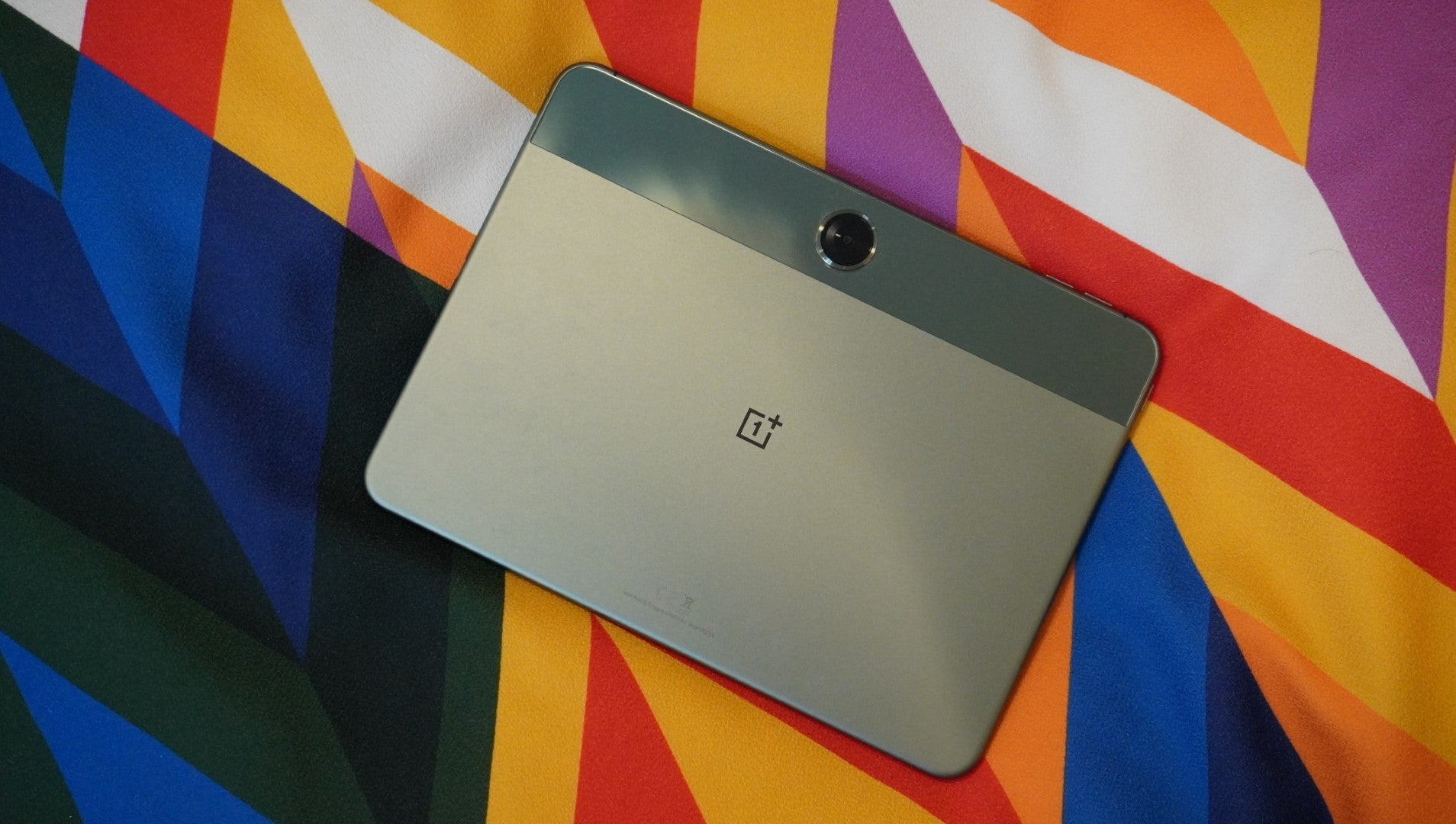First Impressions
The OnePlus Pad Go looks like it could be a solid cheaper alternative to the OnePlus Pad, while also offering a better experience than similarly priced tablets with elements like Dolby Atmos support, a 90Hz display and expandable storage.
Introduction
OnePlus has confirmed that the affordable OnePlus Pad Go is set to enter the European market, and I’ve had a chance to spend some time with the new tablet ahead of launch.
While I’m not yet ready to deliver my full thoughts on the OnePlus Pad Go just yet, I have been pleasantly surprised with the experience after just over 24 hours of use. It feels nice in the hand, the screen is bright and detailed and, although there’s the occasional bit of lag, it’s a pretty smooth experience overall – and all for just £299.
However, as with all budget-focused products, there have been sacrifices to hit the price point. Whether that’ll make or break the experience is yet to be seen, but it has to be noted that the full-fat OnePlus Pad only costs £150 more, and at the time of writing, can be bought for as little as £379, so OnePlus certainly has its work cut out.
Design and screen
- Similar design to OnePlus Pad
- 11.3-inch 90Hz LCD display
- Stereo speakers with Dolby Atmos
Being a cheaper version of the full-fat OnePlus Pad, the OnePlus Pad Go shares some similarities with its bigger brother.

That extends to the design; while it’s different enough to be recognisable next to the OnePlus Pad, it’s clear that the two share the same core DNA, beyond the fact that both are available in the same attractive shade of (what I’ve unofficially dubbed) OnePlus Green.
In fact, the most notable difference between the two – besides the 0.2-inch difference in screen size – can be found on the rear of the OnePlus Pad Go.
In place of a pure aluminium back, the Pad Go sports a glossy strip across the top side, encompassing the rear camera setup. It’s plastic instead of glass, but that’s not really a surprise at the price point. It’s a nice touch as it breaks up the usually bland tablet rear, giving it a level of personality you won’t find on an iPad.
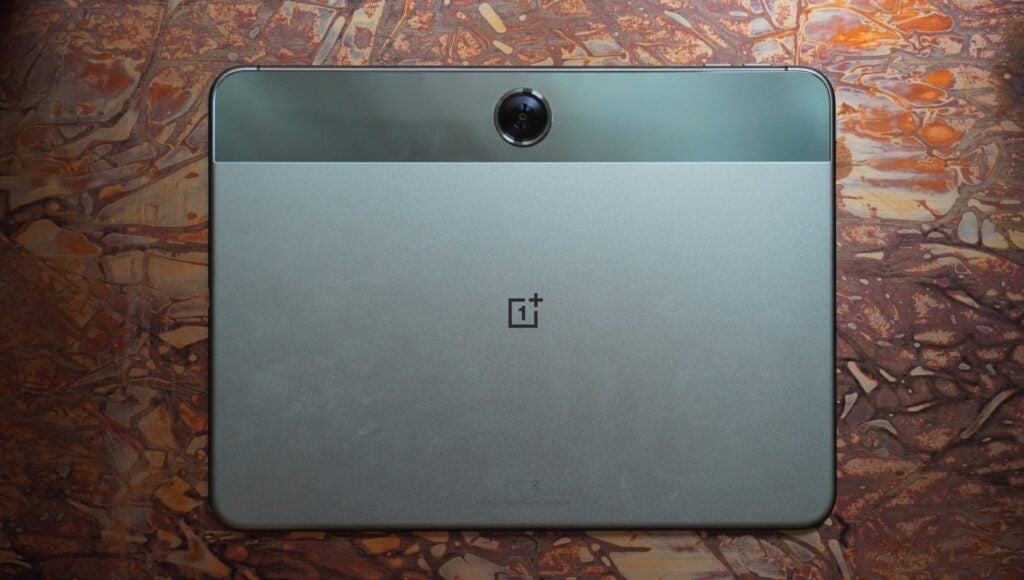
It’s also worth noting that, as with the OnePlus Pad and recent iPads, the OnePlus Pad Go is designed to be used in horizontal aspect ratio, denoted by the selfie camera sitting above the long edge of the tablet’s screen, and the horizontal placement of the rear camera.
This makes a lot of sense for a tablet, allowing for a much more natural camera position when video calling – and that’s something I imagine a lot of people will be doing with the Pad Go, as with any tablet.
When it comes to screen tech, the OnePlus Pad Go sports an 11.3-inch IPS LCD display with a 90Hz refresh rate.
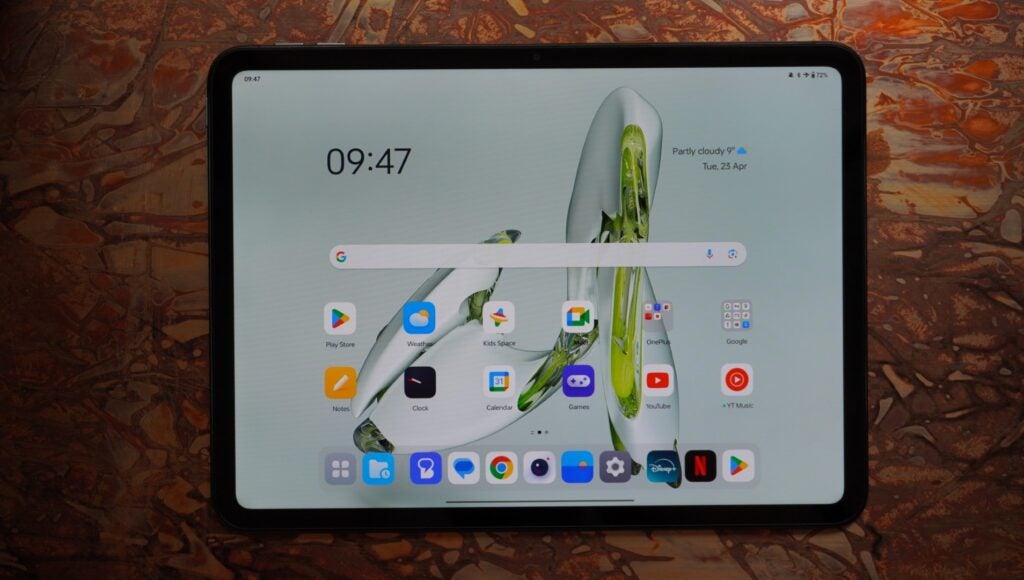
It’s not exactly the most spectacular offering on paper, especially compared to the regular OnePlus Pad that boasts a 144Hz refresh rate and HDR10+ support, but I’ve found it to be more than bright and detailed enough to enjoy streaming Netflix during my usage so far, and I’m looking forward to seeing how it handles gaming with that smooth refresh rate.
Elsewhere, you’ll find stereo speakers, but these aren’t your regular stereo speakers. Despite the competitive price, the Pad Go offers Dolby Atmos support. While I’ve not yet spent enough time with the tablet to comment on audio performance, first impressions are very good, especially when it comes to bass tones. It won’t replace a speaker, but it is surprisingly balanced.
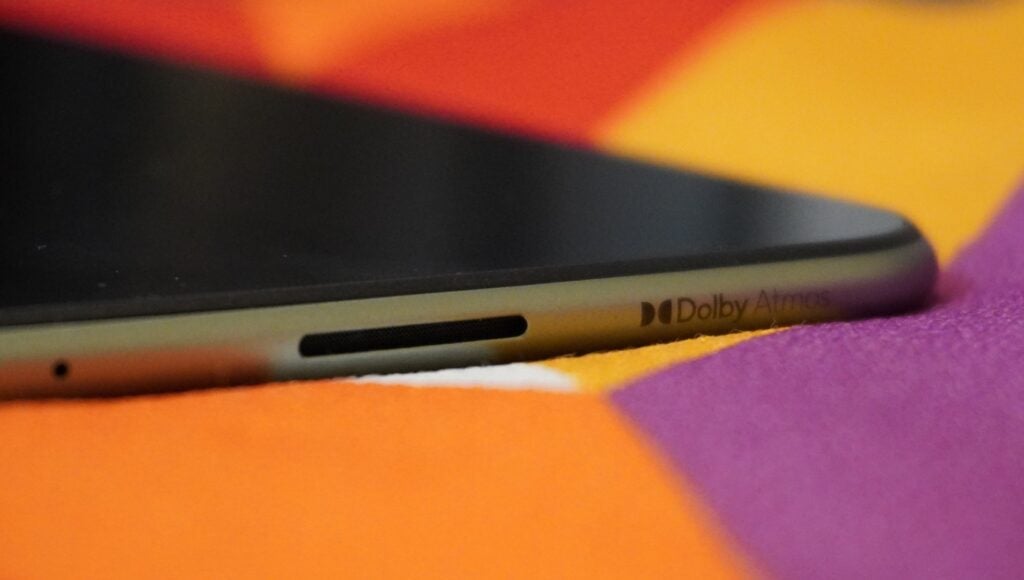
Specs and software
- Helio G99 chip and 8GB of RAM
- Fairly responsive with occasional jitter
- Still running Android 13
While the OnePlus Pad Go looks the part, it is still a budget-focused tablet and the spec reflects this. The tablet sports the 6nm Helio G99 SoC with 8GB of RAM and either 128- or 256GB of UFS 2.2 storage.
That’s not exactly rapid, even compared to the regular OnePlus Pad that only costs £150 more, sporting a faster 4nm Dimensity 8000 chipset, 12GB of RAM and UFS 3.1 storage. The only win that the OnePlus Pad Go scores in this respect is the inclusion of a microSD card slot to expand storage further down the line.
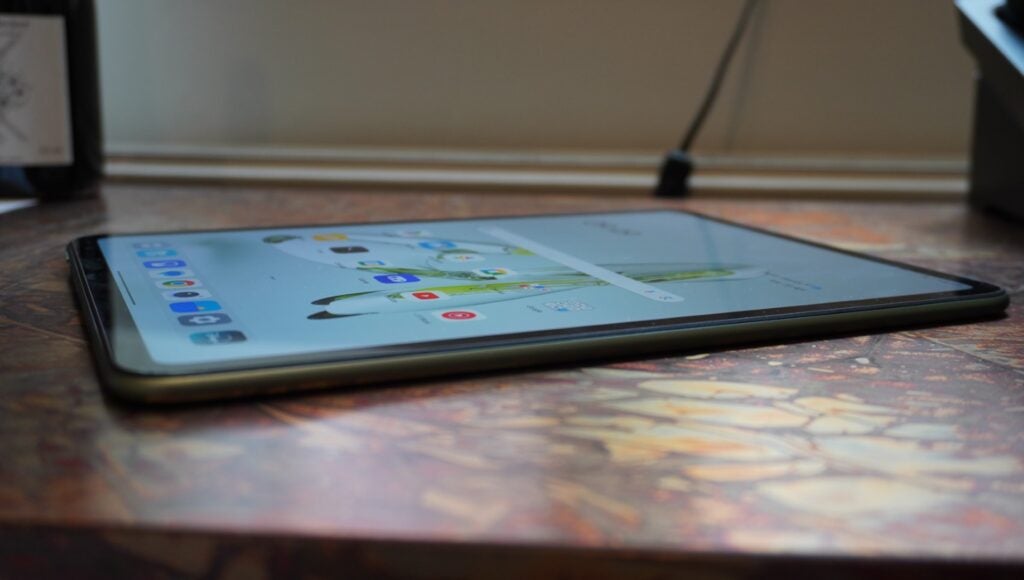
However, I will say that it has felt fairly responsive during my time with the tablet so far, though it does suffer from the occasional jitter or bit of lag, especially when opening and closing apps, and some particularly ad-heavy websites can make the Pad stutter, though that’s arguably more on terrible website UX designers than OnePlus.
I haven’t had a chance to play any games yet, but I’m not expecting it to run particularly demanding titles like Genshin Impact or Call of Duty Mobile with max-level graphics and get a solid frame rate. Lower graphics settings could make it more viable, but I’ll test that and deliver results, along with benchmarks, for the full review.
Elsewhere, you’ll find an 8000mAh battery that should get you through a day’s use and then some – four hours of watching Disney+ drained 24% charge, suggesting pretty solid longevity – but with only 33W fast charging tech, it does take a while to top up.
There’s also a camera setup comprised of an 8MP rear-facing camera and 8MP front-facing camera, though as with most tablets, it’s not that great, and only really ideal for a quick snap or a video call.
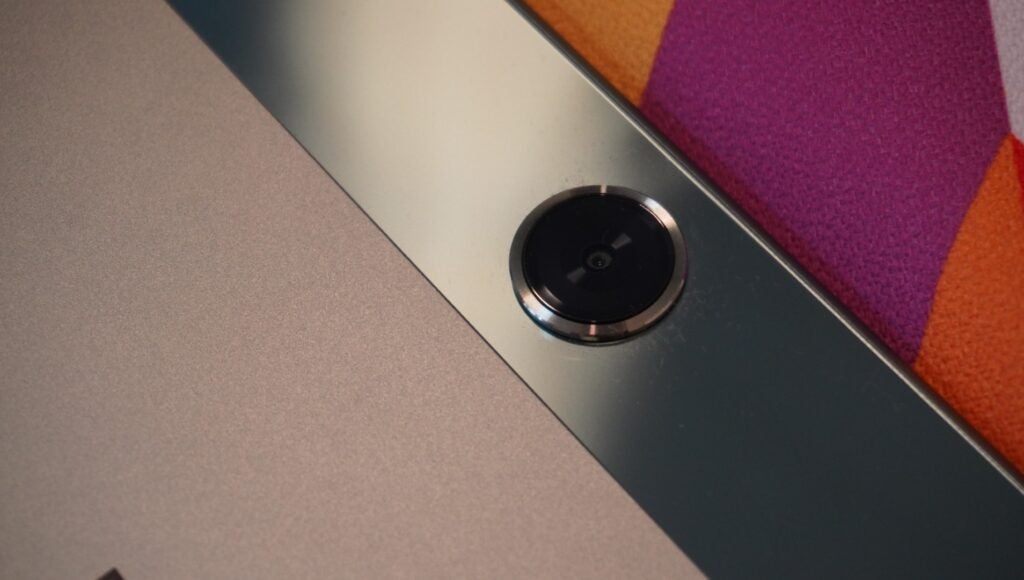
One oddity about the OnePlus Pad Go is its software; while OxygenOS 14, based on Android 14, is available on recent OnePlus releases like the OnePlus 12 and OnePlus Open (via OTA software update) the OnePlus Pad Go is still stuck on OxygenOS 13.2 based on Android 13.
It’s not exactly a huge deal as OxygenOS 14 doesn’t really introduce anything that revolutionary – it’s not iPadOS, which seems to change substantially each year – but it’s annoying that one of the two software updates promised will be used on the move to Android 14, an operating system that has been available for well over six months at this point.
Latest deals
Early Thoughts
The £299 OnePlus Pad Go looks like it could be a solid alternative to the OnePlus Pad while offering a better experience than similarly priced cheap tablets with elements like Dolby Atmos support, a 90Hz display and expandable storage.
However, the fact that the regular OnePlus Pad can be found for only £80 more than the Go at the time of writing muddies what should be a clear-cut buying decision. I’m certainly looking forward to delving deeper into the OnePlus Pad Go offering for the full review in the coming days.
FAQs
The OnePlus Pad Go offers stylus support, but you’ll have to source one separately.
Considering the more expensive OnePlus Pad doesn’t come with a charger, it shouldn’t be much of a surprise to find out that the OnePlus Pad Go doesn’t come with a charger either.
OnePlus has committed to two software updates, though one will bring the tablet up to the current Android 14, running Android 13 at release.
First Impressions
The OnePlus Pad Go looks like it could be a solid cheaper alternative to the OnePlus Pad, while also offering a better experience than similarly priced tablets with elements like Dolby Atmos support, a 90Hz display and expandable storage.
Introduction
OnePlus has confirmed that the affordable OnePlus Pad Go is set to enter the European market, and I’ve had a chance to spend some time with the new tablet ahead of launch.
While I’m not yet ready to deliver my full thoughts on the OnePlus Pad Go just yet, I have been pleasantly surprised with the experience after just over 24 hours of use. It feels nice in the hand, the screen is bright and detailed and, although there’s the occasional bit of lag, it’s a pretty smooth experience overall – and all for just £299.
However, as with all budget-focused products, there have been sacrifices to hit the price point. Whether that’ll make or break the experience is yet to be seen, but it has to be noted that the full-fat OnePlus Pad only costs £150 more, and at the time of writing, can be bought for as little as £379, so OnePlus certainly has its work cut out.
Design and screen
- Similar design to OnePlus Pad
- 11.3-inch 90Hz LCD display
- Stereo speakers with Dolby Atmos
Being a cheaper version of the full-fat OnePlus Pad, the OnePlus Pad Go shares some similarities with its bigger brother.

That extends to the design; while it’s different enough to be recognisable next to the OnePlus Pad, it’s clear that the two share the same core DNA, beyond the fact that both are available in the same attractive shade of (what I’ve unofficially dubbed) OnePlus Green.
In fact, the most notable difference between the two – besides the 0.2-inch difference in screen size – can be found on the rear of the OnePlus Pad Go.
In place of a pure aluminium back, the Pad Go sports a glossy strip across the top side, encompassing the rear camera setup. It’s plastic instead of glass, but that’s not really a surprise at the price point. It’s a nice touch as it breaks up the usually bland tablet rear, giving it a level of personality you won’t find on an iPad.

It’s also worth noting that, as with the OnePlus Pad and recent iPads, the OnePlus Pad Go is designed to be used in horizontal aspect ratio, denoted by the selfie camera sitting above the long edge of the tablet’s screen, and the horizontal placement of the rear camera.
This makes a lot of sense for a tablet, allowing for a much more natural camera position when video calling – and that’s something I imagine a lot of people will be doing with the Pad Go, as with any tablet.
When it comes to screen tech, the OnePlus Pad Go sports an 11.3-inch IPS LCD display with a 90Hz refresh rate.

It’s not exactly the most spectacular offering on paper, especially compared to the regular OnePlus Pad that boasts a 144Hz refresh rate and HDR10+ support, but I’ve found it to be more than bright and detailed enough to enjoy streaming Netflix during my usage so far, and I’m looking forward to seeing how it handles gaming with that smooth refresh rate.
Elsewhere, you’ll find stereo speakers, but these aren’t your regular stereo speakers. Despite the competitive price, the Pad Go offers Dolby Atmos support. While I’ve not yet spent enough time with the tablet to comment on audio performance, first impressions are very good, especially when it comes to bass tones. It won’t replace a speaker, but it is surprisingly balanced.

Specs and software
- Helio G99 chip and 8GB of RAM
- Fairly responsive with occasional jitter
- Still running Android 13
While the OnePlus Pad Go looks the part, it is still a budget-focused tablet and the spec reflects this. The tablet sports the 6nm Helio G99 SoC with 8GB of RAM and either 128- or 256GB of UFS 2.2 storage.
That’s not exactly rapid, even compared to the regular OnePlus Pad that only costs £150 more, sporting a faster 4nm Dimensity 8000 chipset, 12GB of RAM and UFS 3.1 storage. The only win that the OnePlus Pad Go scores in this respect is the inclusion of a microSD card slot to expand storage further down the line.

However, I will say that it has felt fairly responsive during my time with the tablet so far, though it does suffer from the occasional jitter or bit of lag, especially when opening and closing apps, and some particularly ad-heavy websites can make the Pad stutter, though that’s arguably more on terrible website UX designers than OnePlus.
I haven’t had a chance to play any games yet, but I’m not expecting it to run particularly demanding titles like Genshin Impact or Call of Duty Mobile with max-level graphics and get a solid frame rate. Lower graphics settings could make it more viable, but I’ll test that and deliver results, along with benchmarks, for the full review.
Elsewhere, you’ll find an 8000mAh battery that should get you through a day’s use and then some – four hours of watching Disney+ drained 24% charge, suggesting pretty solid longevity – but with only 33W fast charging tech, it does take a while to top up.
There’s also a camera setup comprised of an 8MP rear-facing camera and 8MP front-facing camera, though as with most tablets, it’s not that great, and only really ideal for a quick snap or a video call.

One oddity about the OnePlus Pad Go is its software; while OxygenOS 14, based on Android 14, is available on recent OnePlus releases like the OnePlus 12 and OnePlus Open (via OTA software update) the OnePlus Pad Go is still stuck on OxygenOS 13.2 based on Android 13.
It’s not exactly a huge deal as OxygenOS 14 doesn’t really introduce anything that revolutionary – it’s not iPadOS, which seems to change substantially each year – but it’s annoying that one of the two software updates promised will be used on the move to Android 14, an operating system that has been available for well over six months at this point.
Latest deals
Early Thoughts
The £299 OnePlus Pad Go looks like it could be a solid alternative to the OnePlus Pad while offering a better experience than similarly priced cheap tablets with elements like Dolby Atmos support, a 90Hz display and expandable storage.
However, the fact that the regular OnePlus Pad can be found for only £80 more than the Go at the time of writing muddies what should be a clear-cut buying decision. I’m certainly looking forward to delving deeper into the OnePlus Pad Go offering for the full review in the coming days.
FAQs
The OnePlus Pad Go offers stylus support, but you’ll have to source one separately.
Considering the more expensive OnePlus Pad doesn’t come with a charger, it shouldn’t be much of a surprise to find out that the OnePlus Pad Go doesn’t come with a charger either.
OnePlus has committed to two software updates, though one will bring the tablet up to the current Android 14, running Android 13 at release.



















